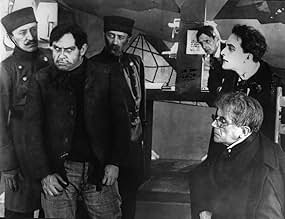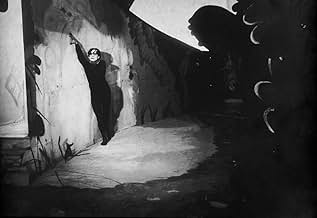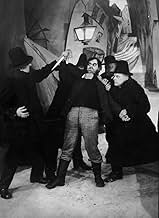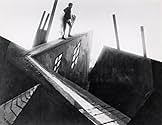CALIFICACIÓN DE IMDb
8.0/10
74 k
TU CALIFICACIÓN
El doctor Caligari, un hipnotista, usa a Cesare, sonámbulo, para cometer asesinatos.El doctor Caligari, un hipnotista, usa a Cesare, sonámbulo, para cometer asesinatos.El doctor Caligari, un hipnotista, usa a Cesare, sonámbulo, para cometer asesinatos.
- Dirección
- Guionistas
- Elenco
- Premios
- 2 premios ganados y 1 nominación en total
Friedrich Feher
- Franzis
- (as Friedrich Fehér)
Hans Heinrich von Twardowski
- Alan
- (as Hans Heinz v. Twardowski)
Rudolf Lettinger
- Dr. Olsen
- (as Rudolph Lettinger)
Rudolf Klein-Rogge
- Ein Verbrecher
- (sin créditos)
- …
Hans Lanser-Ludolff
- Ein Alter Mann
- (sin créditos)
- …
Henri Peters-Arnolds
- Ein Junger Arzt
- (sin créditos)
- …
Ludwig Rex
- Ein Mörder
- (sin créditos)
- …
Elsa Wagner
- Die Wirtin
- (sin créditos)
- …
- Dirección
- Guionistas
- Todo el elenco y el equipo
- Producción, taquilla y más en IMDbPro
Opiniones destacadas
The original message of this film is fairly pedestrian (an outcry against the weak authority in Germany at the time), although the political intrigue surrounding the production led to a fascinating framing story which re-established "the authorities," and in turn made the UFA happy enough to distribute the film. This suggests that in its own time the political message of the film was fairly powerful, but compared to the work done in such films as The Golem, Nosferatu, and Metropolis it is not so far-reaching.
What sets this film apart from its contemporaries is its absolute commitment to the expressionist movement. Mutated sets, heavy dark/light makeup, light and shadow, and a Gothic storyline are classic expressionism. The photography is beautiful and so crisp that it creates an eerie sense that this hellish scene is actually the real world, and that our everyday lives are the delusional Technicolor dream of a madman.
While there are many better movies made in this period, I feel that this one is the pinnacle of the imagery that is characteristic of the expressionist art form. It is an absolute must-see for anyone who is interested in the Expressionist movement.
What sets this film apart from its contemporaries is its absolute commitment to the expressionist movement. Mutated sets, heavy dark/light makeup, light and shadow, and a Gothic storyline are classic expressionism. The photography is beautiful and so crisp that it creates an eerie sense that this hellish scene is actually the real world, and that our everyday lives are the delusional Technicolor dream of a madman.
While there are many better movies made in this period, I feel that this one is the pinnacle of the imagery that is characteristic of the expressionist art form. It is an absolute must-see for anyone who is interested in the Expressionist movement.
With a story as twisted, buckled and demented as the scenery and set design, and a tortured score to boot, was the lunatic in charge of the asylum? Must have been a moment to remember coming across this cinematic marvel back in 1920. I wonder how many of today's pieces of cinema will stand the test of 100 years, albeit with a lot more competition.
I vowed to see more horror films this year, and this was recommended to me, initially I was a little dubious with it being a hundred plus years old, and a silent film, but I have to say I have a real appreciation for it.
Without a doubt, this film must be the inspiration for the whole horror genre, a genre that scares and shocks people to this day, you can only I shine the profound effect that this film must have had on viewers back in its time.
Hugely atmospheric and creepy, if I'm honest, it is slow, and you do need to concentrate, or you'll lose it, no texting or phone play, it is a fairly intense watch, best of all is the ending, which really does come as a surprise, it's something of a twist.
It is definitely not for everyone, and if you're used to modern horror, you may find ten minutes of it an arduous task, but having watched Nose earlier in the year, I have a real appreciation for this early gem.
An admirable film, 8/10.
Without a doubt, this film must be the inspiration for the whole horror genre, a genre that scares and shocks people to this day, you can only I shine the profound effect that this film must have had on viewers back in its time.
Hugely atmospheric and creepy, if I'm honest, it is slow, and you do need to concentrate, or you'll lose it, no texting or phone play, it is a fairly intense watch, best of all is the ending, which really does come as a surprise, it's something of a twist.
It is definitely not for everyone, and if you're used to modern horror, you may find ten minutes of it an arduous task, but having watched Nose earlier in the year, I have a real appreciation for this early gem.
An admirable film, 8/10.
This movie was shot between 1919 and 1920, a few decades since the motion picture camera was invented, and the Lumière brothers were in the middle of their experiments with it. At the time, cinema was being considered as a new way of making art, and yo make art you had to marry with a serie of ideas: ideology, aesthetics, cosmogony, etc. In these terms, this movie belongs to the German expressionism, which is reflected in the entire setup: from characters make up to the background of the set.
Having an average murder-mystery plot, the movie can be defined as a painting with some action occurring in it. The whole scenario was displayed following the same criteria as in expressionist painting: all diagonal and curve lines, evading the straightness and the cardinal orientation of things, wicked perspectives and proportions. Even the more minimum detail was carefully considered to fulfill the aesthetics needs. The result couldn't have been better, considering that the only visual trick they could do was to shrink/enlarge the camera's diafragma. Think that this was before the concept of travelling was even developed.
Concerning the plot, yet it's true that it isn't really the great thing and that many people now a days find it boring, I got to enjoy it, further than its aesthetical function (I even got to laugh in a couple of scenes), and I highly recommend it, as a good old piece of art from which many of today's film makers may take some good lessons on how to approach movies. I'm sure that if they got understand that, then there would be much lesser crappy movies than there are now a days.
Having an average murder-mystery plot, the movie can be defined as a painting with some action occurring in it. The whole scenario was displayed following the same criteria as in expressionist painting: all diagonal and curve lines, evading the straightness and the cardinal orientation of things, wicked perspectives and proportions. Even the more minimum detail was carefully considered to fulfill the aesthetics needs. The result couldn't have been better, considering that the only visual trick they could do was to shrink/enlarge the camera's diafragma. Think that this was before the concept of travelling was even developed.
Concerning the plot, yet it's true that it isn't really the great thing and that many people now a days find it boring, I got to enjoy it, further than its aesthetical function (I even got to laugh in a couple of scenes), and I highly recommend it, as a good old piece of art from which many of today's film makers may take some good lessons on how to approach movies. I'm sure that if they got understand that, then there would be much lesser crappy movies than there are now a days.
10Gafke
Made in 1919, "The Cabinet of Doctor Caligari" was literally years ahead of its time and remains a triumphant accomplishment in the genre of German Expressionism. Remembered mainly for its stunning sets, which featured crooked buildings and twisted landscapes, "Cabinet" also boasts one of the first attempts at a twist ending, something quite new and shocking for its time.
Told mainly from the point of view of Francis, a young man who lives in the small village of Holstenwall, Germany, "Cabinet" tells the tale of murder and madness which seems to accompany the arrival of a carnival. Francis and his best friend Alan go to the carnival and are presented with the sideshow attraction Cesare the Somnambulist, a gaunt and hideous young man who spends his life sleeping in a coffin-like cabinet and seems able to predict the future when awake. Cesare (played by a young Conrad Veidt, who later went on to play the evil Nazi general in Casablanca) informs Alan that he will soon die, and indeed, Alan is found murdered the next morning. Suspicion turns to the eerie somnambulist and his strange keeper, a man called Caligari. As Francis desperately tries to solve the mystery and find his friends killer, it seems that the beautiful young Jane, beloved by both Alan and Francis, has been targeted as the next victim.
This is a genuinely creepy film which delves deep into the mysteries of the abnormal mind...an uncomfortable journey to say the least. Everyone is suspect and, in the end, we must ask ourselves: "who is really the mad one here?"
Subtle and ingenious, we see the world the way an insane person might see it; warped and confused, a nightmarish terrain where nothing makes sense and balance is not to be found.
The impact of this film is still being felt and seen today, and for good reason. It is a shocking, disturbing masterpiece. I cannot recommend it highly enough.
Told mainly from the point of view of Francis, a young man who lives in the small village of Holstenwall, Germany, "Cabinet" tells the tale of murder and madness which seems to accompany the arrival of a carnival. Francis and his best friend Alan go to the carnival and are presented with the sideshow attraction Cesare the Somnambulist, a gaunt and hideous young man who spends his life sleeping in a coffin-like cabinet and seems able to predict the future when awake. Cesare (played by a young Conrad Veidt, who later went on to play the evil Nazi general in Casablanca) informs Alan that he will soon die, and indeed, Alan is found murdered the next morning. Suspicion turns to the eerie somnambulist and his strange keeper, a man called Caligari. As Francis desperately tries to solve the mystery and find his friends killer, it seems that the beautiful young Jane, beloved by both Alan and Francis, has been targeted as the next victim.
This is a genuinely creepy film which delves deep into the mysteries of the abnormal mind...an uncomfortable journey to say the least. Everyone is suspect and, in the end, we must ask ourselves: "who is really the mad one here?"
Subtle and ingenious, we see the world the way an insane person might see it; warped and confused, a nightmarish terrain where nothing makes sense and balance is not to be found.
The impact of this film is still being felt and seen today, and for good reason. It is a shocking, disturbing masterpiece. I cannot recommend it highly enough.
¿Sabías que…?
- TriviaWriter Hans Janowitz claims to have gotten the idea for the film when he was at a carnival one day. He saw a strange man lurking in the shadows. The next day he heard that a girl was brutally murdered there. He went to the funeral and saw the same man lurking around. He had no proof that the strange man was the murderer, but he fleshed the whole idea out into his film.
- ErroresIn the wide shot, the sign at the asylum reads "Insane Asylum," in English. In the close-up, the sign is written in German (Kino Blu-ray Disc version, may not be present in all editions of the film).
- Versiones alternativasUSA laserdisc reissue restores the original hand-drawn title cards that have been missing from every known print of the film since 1923. When first released on video in the United States, film was in black-and-white, and played back many scenes at double speed and featured different music. Although no scenes were cut out, the running time was reduced to only 51 minutes. The restored version restores the colour-tinting, restores the original title cards, and plays the film back at regular speed, returning the film to its original 69-minute running time.
- ConexionesEdited into People Who Die Mysteriously in Their Sleep (2004)
Selecciones populares
Inicia sesión para calificar y agrega a la lista de videos para obtener recomendaciones personalizadas
Detalles
- Fecha de lanzamiento
- País de origen
- Idioma
- También se conoce como
- The Cabinet of Dr. Caligari
- Locaciones de filmación
- Productora
- Ver más créditos de la compañía en IMDbPro
Taquilla
- Presupuesto
- USD 18,000 (estimado)
- Total en EE. UU. y Canadá
- USD 8,811
- Total a nivel mundial
- USD 9,297
- Tiempo de ejecución
- 1h 16min(76 min)
- Mezcla de sonido
- Relación de aspecto
- 1.37 : 1
Contribuir a esta página
Sugiere una edición o agrega el contenido que falta





























